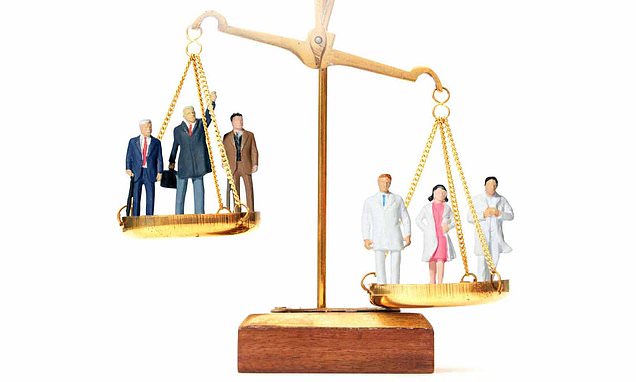Examining The Financial Impact Of Public Sector Pensions On Taxpayers

Table of Contents
Understanding Public Sector Pension Funding Models
Public sector pensions, providing retirement income to government employees, operate under various funding models. The most common are defined benefit (DB), defined contribution (DC), and hybrid plans. The chosen model significantly impacts the financial burden on taxpayers.
-
Defined Benefit (DB) Plans: These plans guarantee a specific monthly payment upon retirement, based on salary and years of service. This model shifts significant investment risk and longevity risk to the taxpayer. If investment returns are poor, or employees live longer than anticipated, the taxpayer bears the cost. The higher the guaranteed benefit, the greater the taxpayer's risk. This is often viewed as a significant liability in terms of pension funding.
-
Defined Contribution (DC) Plans: In DC plans, both the employee and the employer contribute to an individual account. The employee's retirement income depends on the investment performance of these funds. This model transfers investment risk to the employee while reducing the immediate taxpayer's financial risk related to pension liabilities. However, the employee bears the risk of market fluctuations.
-
Hybrid Plans: Many jurisdictions use hybrid models, combining elements of DB and DC plans. These plans attempt to balance the risks and costs between taxpayers and employees, but this requires careful management of pension funding and ongoing liability assessment.
The Growing Burden of Unfunded Public Sector Pension Liabilities
A critical aspect of public sector pension finances is the issue of unfunded liabilities. These represent the difference between the present value of future pension obligations and the assets currently available to meet those obligations. The growth of unfunded liabilities is a significant concern.
Several factors contribute to this growth:
- Increasing Life Expectancy: People are living longer, meaning pension payments are drawn out for extended periods, increasing the overall cost.
- Generous Benefit Packages: Some public sector pension plans offer exceptionally generous benefits, including early retirement options and cost-of-living adjustments that significantly impact pension debt.
- Poor Investment Returns: Periods of low investment returns can exacerbate the unfunded liability problem, especially for DB plans.
The consequences of large unfunded pension liabilities are substantial, impacting taxpayers through:
- Increased Tax Burdens: Governments may need to raise taxes to cover these shortfalls.
- Reduced Public Services: Funding for essential public services may be cut to allocate resources towards pensions.
- Damaged Credit Ratings: Large unfunded liabilities can negatively impact a government's credit rating, making it more expensive to borrow money.
Analyzing the Cost of Public Sector Pension Benefits
The cost of public sector pension benefits includes not just retirement annuities but also healthcare coverage, survivor benefits, and other provisions. Analyzing the cost relative to taxpayer contributions reveals the true financial burden.
- Comparison to Private Sector: Comparing public sector pension benefits to those in the private sector reveals significant differences, often with public sector benefits being more generous.
- Cost-of-Living Adjustments: Automatic cost-of-living adjustments (COLAs) increase benefits annually, adding to the long-term cost.
- Early Retirement Options: Allowing early retirement adds to the overall cost due to longer payout periods.
Pension reform efforts often focus on modifying benefit formulas to ensure fiscal sustainability and reduce the financial strain on taxpayers related to pension benefits and retirement benefits.
Exploring Potential Reforms for Public Sector Pension Systems
Addressing the financial challenges posed by public sector pensions requires comprehensive reforms. Various options exist, each with pros and cons:
- Increased Employee Contributions: Requiring higher contributions from employees can reduce the burden on taxpayers.
- Raising the Retirement Age: Delaying retirement can lower the total payout, reducing pension system costs.
- Modifying Benefit Formulas: Changes to benefit calculation formulas can limit the growth of future liabilities.
- Shifting to Defined Contribution Plans: Transitioning to DC plans shifts investment risk to employees, mitigating the taxpayer's long-term exposure to pension liabilities.
These reforms have significant political and social implications, requiring careful consideration of their impact on employees and the public. Effective pension system reform necessitates a delicate balance between fiscal responsibility and the needs of public sector employees.
The Long-Term Implications of Public Sector Pensions on Taxpayers
The financial impact of public sector pensions on taxpayers is significant and multifaceted. Understanding the different funding models, the implications of unfunded liabilities, and the cost of benefits is essential for responsible financial planning and informed civic participation. The need for prudent management and timely reforms is undeniable to ensure the long-term fiscal sustainability of public sector pension systems.
Stay informed about the impact of public sector pensions on your taxes. Learn more about public sector pension reform in your area and engage in informed discussions about potential solutions. Further research into your local pension plan and state pension fund will provide valuable insights into this crucial issue. Use keywords like "public sector pension reform," "local pension plan," and "state pension fund" to continue your research and become a more engaged citizen.

Featured Posts
-
 Louisville Mail Delays End In Sight Says Postal Union Leader
Apr 29, 2025
Louisville Mail Delays End In Sight Says Postal Union Leader
Apr 29, 2025 -
 Uk Courts Definition Of Woman Impact On Sex Based Rights And Transgender Issues
Apr 29, 2025
Uk Courts Definition Of Woman Impact On Sex Based Rights And Transgender Issues
Apr 29, 2025 -
 Analyzing Trumps Possible Pardon Of Banned Mlb Player Pete Rose
Apr 29, 2025
Analyzing Trumps Possible Pardon Of Banned Mlb Player Pete Rose
Apr 29, 2025 -
 Dc Crash Investigation Nyt Reveals Black Hawk Pilots Actions
Apr 29, 2025
Dc Crash Investigation Nyt Reveals Black Hawk Pilots Actions
Apr 29, 2025 -
 Bombshell Report Uncovering The Causes Of The Black Hawk And Jet Crash That Killed 67
Apr 29, 2025
Bombshell Report Uncovering The Causes Of The Black Hawk And Jet Crash That Killed 67
Apr 29, 2025
